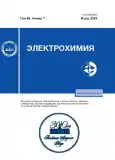Том 59, № 7 (2023)
Статьи
Структура и электрохимические свойства катодных материалов (Na3V2 − xScx(PO4)3) для натрий-ионных аккумуляторов
Аннотация
Твердые растворы Na3V2 − xScx(PO4)3 (0 < x < 2) синтезированы золь–гель-методом с дальнейшим отжигом в инертной атмосфере. Методом порошковой рентгеновской дифракции проведено структурное исследование соединений Na3V2 − xScx(PO4)3 (x = 0.5, 1.2). По мере увеличения степени замещения наблюдается закономерный рост параметров и объема элементарной ячейки с сохранением структурного типа NASICON. Электрохимические свойства материалов Na3V2 − xScx(PO4)3/C в качестве катодов для натрий-ионных аккумуляторов исследованы в натриевых полуячейках в различных диапазонах потенциалов: 2.5−3.8 В, 2.5−4.5 В и 1.0−4.5 В отн. Na/Na+. На зарядных кривых для всех материалов присутствуют два плато: при ≈3.5 и ≈4 В отн. Na/Na+, соответствующие последовательным переходам V3+/V4+ и V4+/V5+, однако только для материала Na3V1.5Sc0.5(PO4)3/C высоковольтное плато является обратимым при последующем разряде. Это делает возможным стабильное обратимое циклирование этого материала в интервале потенциалов 1.0−4.5 В отн. Na/Na+ с емкостью более 170 мА ч г−1, что соответствует (де)интеркаляции 3Na+ на формульную единицу.
 369-377
369-377


Электрокристаллизация металлов в каналах пористых пленок анодного оксида алюминия: реальная структура темплата и количественная модель электроосаждения
Аннотация
Предложена методика аналитического описания транзиентов тока при темплатном электроосаждении металла в пористые пленки анодного оксида алюминия (АОА). Проведено темплатное электроосаждение меди и золота. На примере электроосаждения меди показано, что экспериментальные данные количественно согласуются с расчетными значениями тока без использования подгоночных параметров. Измерены характеристики структуры пленок АОА, включая конусность пор и количество тупиковых каналов, исследовано влияние этих особенностей на процесс темплатного электроосаждения.
 378-390
378-390


Модельное описание процесса электроосаждения рыхлых осадков цинка в импульсных режимах задания тока
Аннотация
Представлена феноменологическая модель, описывающая изменение структурных характеристик рыхлых осадков цинка, полученных в импульсных гальваностатических режимах задания тока. Сопоставление экспериментальных данных по структурным свойствам осадков с результатами модельных расчетов указывает на адекватность модели. Для описания особенностей роста дендритных осадков и определения продолжительности формирования однородной структуры в импульсных режимах введено понятие критической толщины, при которой происходит резкое изменение плотности рыхлого осадка. Установлена зависимость критической толщины осадков цинка от скважности при импульсных режимах задания тока. Повышение скважности приводит к получению более плотных осадков с огрубленными формами дендритов и с меньшим количеством точек роста, по сравнению с осадками, полученными в гальваностатическом режиме.
 391-403
391-403


Коррозия низкоуглеродистой стали в потоке раствора фосфорной кислоты, содержащего фосфат железа(III)
Аннотация
Рассмотрены теоретические аспекты коррозии низкоуглеродистой стали в растворах H3PO4, содержащих FePO4. В исследуемой системе термодинамически разрешены реакции железа с раствором кислоты и солью Fe(III). Окислительная способность этой среды, характеризуемая редокс-потенциалом пары Fe(III)/Fe(II), во многом определяется ее анионным составом. Фосфат-анионы коррозионной среды связывают катионы Fe(III) в комплексные соединения, снижая их окислительную способность. В растворах H3PO4, содержащих FePO4 и Fe3(PO4)2, зависимость редокс-потенциала системы от относительного содержания катионов Fe(III) и Fe(II) плохо описывается уравнением Нернста, что обусловлено неэквивалентным комплексообразованием этих катионов с фосфат-анионами. Анализ влияния конвекции исследуемых сред на электродные реакции низкоуглеродистой стали позволил выявить некоторые их особенности. В растворе H3PO4, содержащей FePO4, на стали реализуются контролируемые кинетикой парциальные реакции анодной ионизации железа и катодного восстановления H+, а также определяемое диффузией катодное восстановление катионов Fe(III). Ускоряющее действие FePO4 на коррозию стали в растворе H3PO4 обусловлено только восстановлением Fe(III), но не влияет на восстановление H+ и ионизацию железа. Экспериментально определено значение коэффициента диффузии катионов Fe(III) в исследуемой коррозионной среде как из данных циклической вольтамерометрии Pt-электрода, так и результатов исследования катодной реакции стального дискового электрода при разной частоте его вращения. Данные по скорости коррозии низкоуглеродистой стали в потоке исследуемых сред, полученные по массопотере металлических образцов, находятся в полном соответствии с результатами исследования парциальных электродных реакций. Наблюдается ускоряющее действие FePO4 на коррозию стали в растворах H3PO4. В этих средах коррозия стали определяется конвективным фактором, что характерно для процессов с диффузионным контролем. Эмпирическая зависимость скорости коррозии стали от интенсивности потока среды описывается линейной зависимостью k = kst + λw1/2, где kst − скорость коррозии в статической среде, w − частота вращения пропеллерной мешалки, λ − эмпирический коэффициент.
 404-416
404-416


Анализ спектров электрохимического импеданса литиевого электрода с использованием функции распределения времен релаксации
Аннотация
В работе рассмотрена возможность анализа спектров электрохимического импеданса литий-литиевых ячеек с использованием функции распределения времен релаксации (Distribution of Relaxation Times – DRT). Выполнен сопоставительный анализ спектров электрохимического импеданса литий-литиевых ячеек, полученных при длительном хранении при постоянной температуре и при различных температурах, методом эквивалентных электрических схем и с помощью функции распределения времен релаксации. Показано, что при анализе импедансов литий-литиевых ячеек с помощью функции распределения времен релаксации можно оценить количество слоев в поверхностной пленке на литиевом электроде и оценить их физические параметры – сопротивление и емкость. Установлено, что при длительной выдержке литий-литиевых ячеек при температуре 30°C количество слоев в поверхностной пленке и ее сопротивление уменьшаются. С повышением температуры происходит дифференциация физических свойств слоев поверхностной пленки и уменьшение ее общего сопротивления. Анализ спектров электрохимического импеданса литий-литиевых ячеек с помощью функции распределения времен релаксации является более информативным по сравнению с методом эквивалентных электрических схем.
 417-430
417-430


РЕКЛАМА
Новое высокоточное российское оборудование для электрохимических измерений SmartStat®
 431-432
431-432










